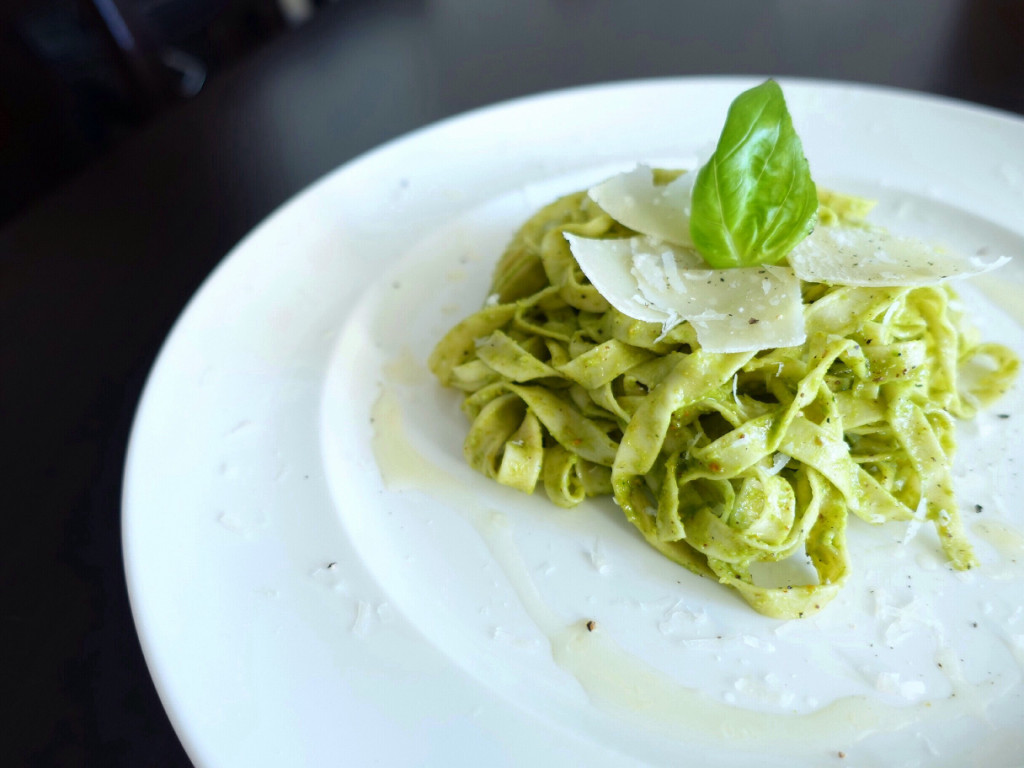Ingredients
4 cups ‘00’ flour
6 large eggs
1 tsp of olive oil
- Start by forming a well with your flour.
- Crack the eggs into the middle of the well and mix with a whisk or fork to break the yolk.
- Gradually, start to incorporate the flour a little bit at a time. This step is key to making the dough silky. If you add the flour too quickly, your pasta will feel dry and will take longer to knead until smooth.
- Knead for approximately 15 minutes. Check the dough by pressing your finger into the dough. It should leave an imprint, but be able to bounce back slightly.
- Form the dough into a ball and let it rest for 1 hour in a glass bowl. To keep your dough from drying out and cracking, cover with saran wrap or cloth.
- It’s best to start making your pasta sauce while your dough is resting. Checkout the YEGFood team’s original ‘Pistachio Pesto’ recipe created especially for this dish.
- Once the dough has rested, you can begin making your pasta! Start by rolling out your dough into a rectangular shape on a flour-dusted countertop.
- Make sure your pasta attachment is secured on tightly to your rolling surface. Attaching your pasta machine to the longest side of your rolling surface is suggested, so that you can avoid folding your pasta over itself. Check that the crank is on the roller side of your attachment and feed your dough through on the zero setting. Note: If you find that the dough to be sticky, dust the dough with more flour before feeding it through the machine again.
- Roll dough through the zero setting once more.
- Change setting from zero to one. Each time the dough is put through the machine, you will want to adjust the setting up to the next highest number before feeding it through again.
- Repeat step 10 until your dough reaches your desired thickness. We used setting 3 as our highest setting, however this may vary depending on personal preference.
- Switch your crank over to the cutting side of the roller. Choose between fettucine or linguine noodles, or do half of each if you can’t decide.
- Before you begin your noodle waterfall be sure to prep 4 flat baking trays, lining each of them with parchment paper and dust with ‘00’ flour.
- Crank your pasta sheet through and get ready for some serious ‘ooh-ing and ahh-ing’! Catch your noodles on prepped floured trays and dust the pasta lightly with more flour so they don’t stick together. Let the pasta rest for 1-2 minutes as you roll out your next pasta sheet..
- Begin shaping the noodles into small nests for storing. These nests help portion out your pasta for later use and prevents the noodles from forming into one big clump.
- Cooking Instructions: throw the pasta into salted boiling water and cook for 1 to 3 minutes until al dente. The cooking time will depend on the thickness of your pasta and the type of pasta. Remember, fresh pasta cooks quickly!
- Store any unused pasta in an airtight container for up to 2 days or stored up to 2 weeks in the freezer.
Note: A stand mixer can be used as well as shown in the displayed photos; you will want to use your paddle attachment initially to mix your ingredients. Switch to your dough hook and gradually increase the speed as more flour is incorporated until you achieve the desired texture (see step 4 above).


